Comprehensive Analysis of Type 2 Diabetes: Care and Management
VerifiedAdded on 2023/06/15
|6
|1512
|68
Report
AI Summary
This report provides a detailed overview of Type 2 diabetes, including its causes, effects, and available treatments. It begins by explaining how Type 2 diabetes develops due to insulin resistance and impaired insulin production, highlighting risk factors such as obesity and family history. The report then outlines the common symptoms and signs of the condition, such as frequent infections, unintended weight loss, and increased thirst. It compares various clinical investigations used for diagnosis, emphasizing the advantages of the Glycated Haemoglobin test. Furthermore, the report examines the support and treatment options available to service users, including lifestyle changes, medication, and surgical interventions, alongside the role of support organizations like Diabetes UK. Finally, it addresses both short-term and long-term complications associated with Type 2 diabetes and suggests preventive measures and treatment strategies, with a mention of resources like the Diabetes UK helpline for additional support. Desklib provides access to similar assignments and study tools for students.
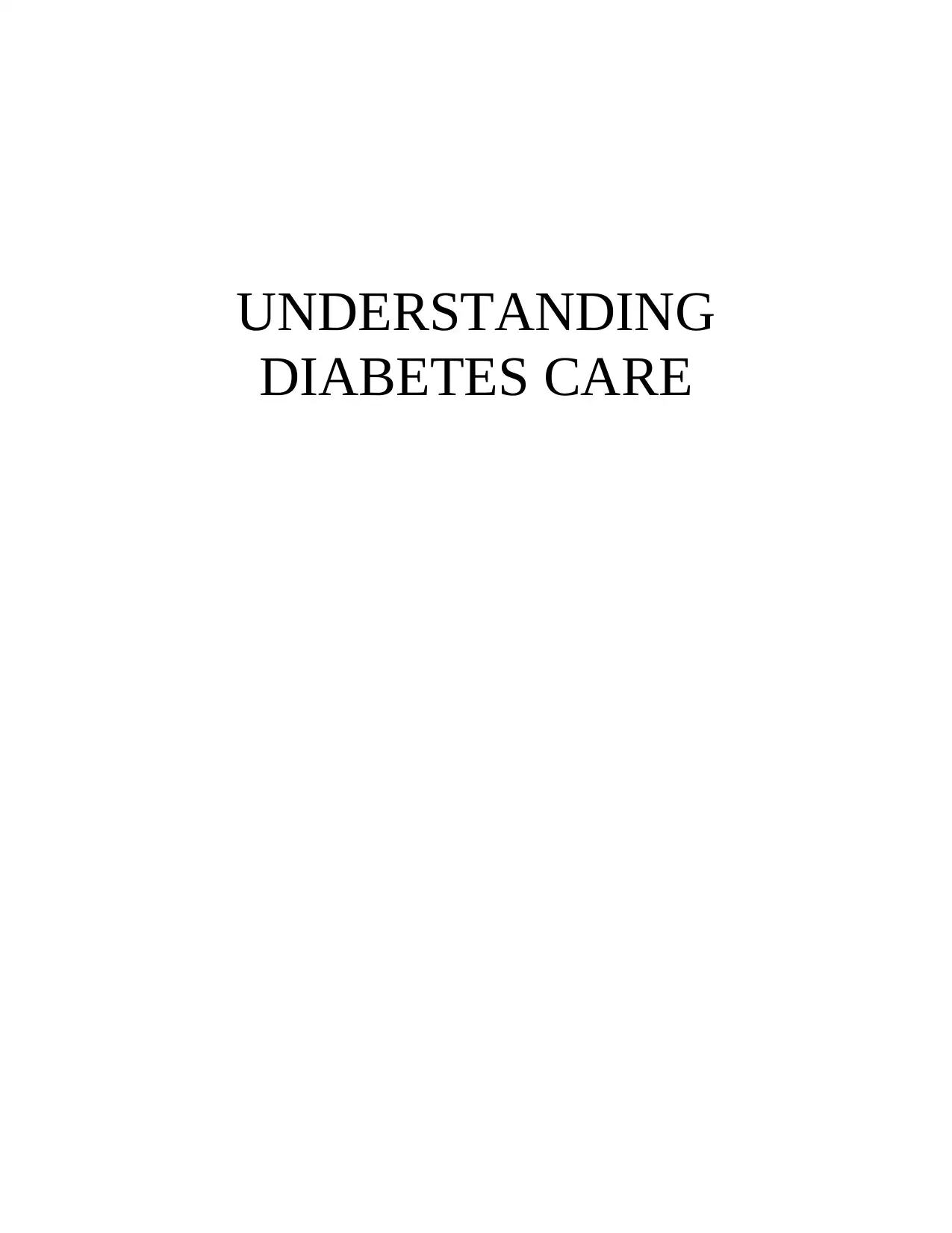
UNDERSTANDING
DIABETES CARE
DIABETES CARE
Paraphrase This Document
Need a fresh take? Get an instant paraphrase of this document with our AI Paraphraser
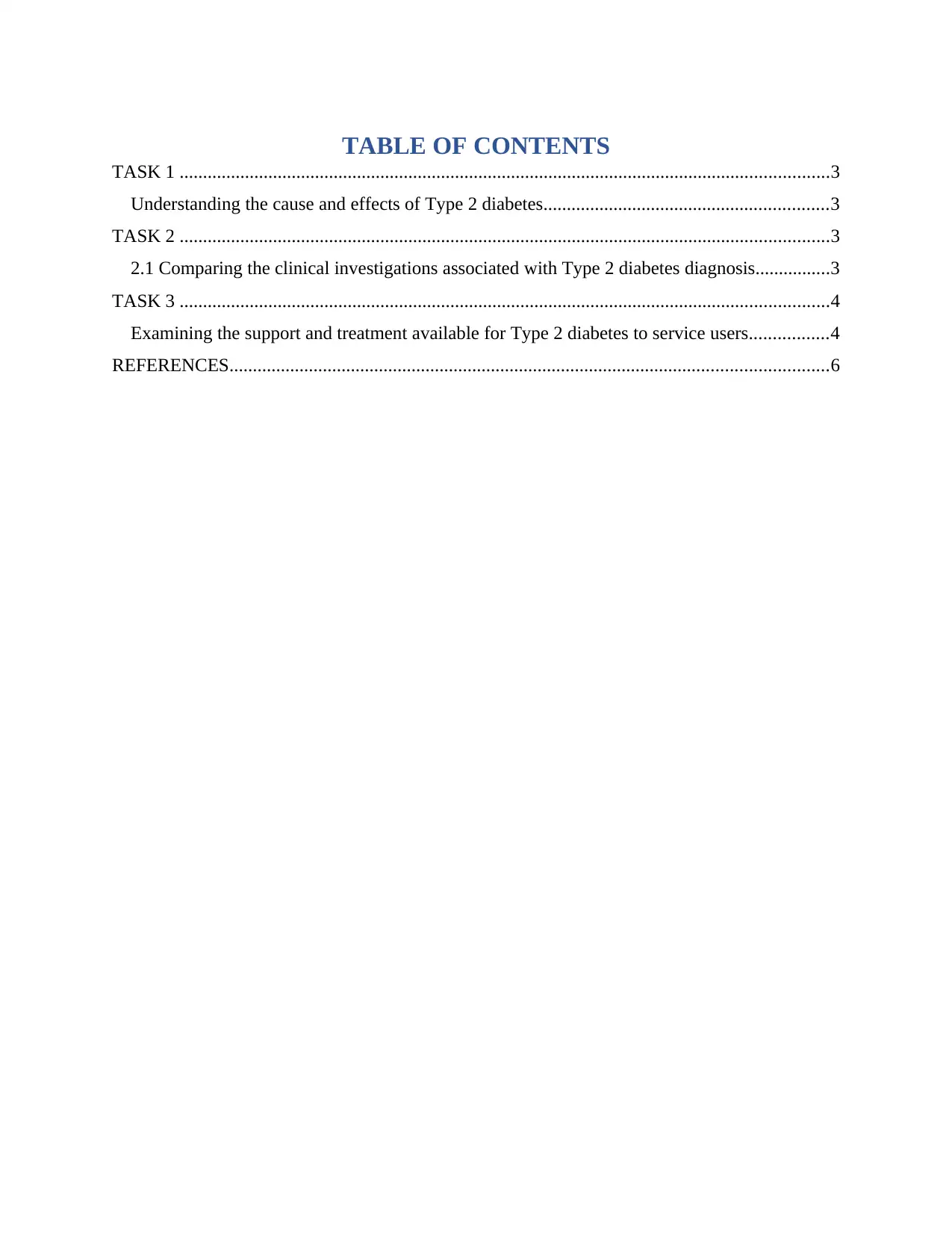
TABLE OF CONTENTS
TASK 1 ...........................................................................................................................................3
Understanding the cause and effects of Type 2 diabetes.............................................................3
TASK 2 ...........................................................................................................................................3
2.1 Comparing the clinical investigations associated with Type 2 diabetes diagnosis................3
TASK 3 ...........................................................................................................................................4
Examining the support and treatment available for Type 2 diabetes to service users.................4
REFERENCES................................................................................................................................6
TASK 1 ...........................................................................................................................................3
Understanding the cause and effects of Type 2 diabetes.............................................................3
TASK 2 ...........................................................................................................................................3
2.1 Comparing the clinical investigations associated with Type 2 diabetes diagnosis................3
TASK 3 ...........................................................................................................................................4
Examining the support and treatment available for Type 2 diabetes to service users.................4
REFERENCES................................................................................................................................6
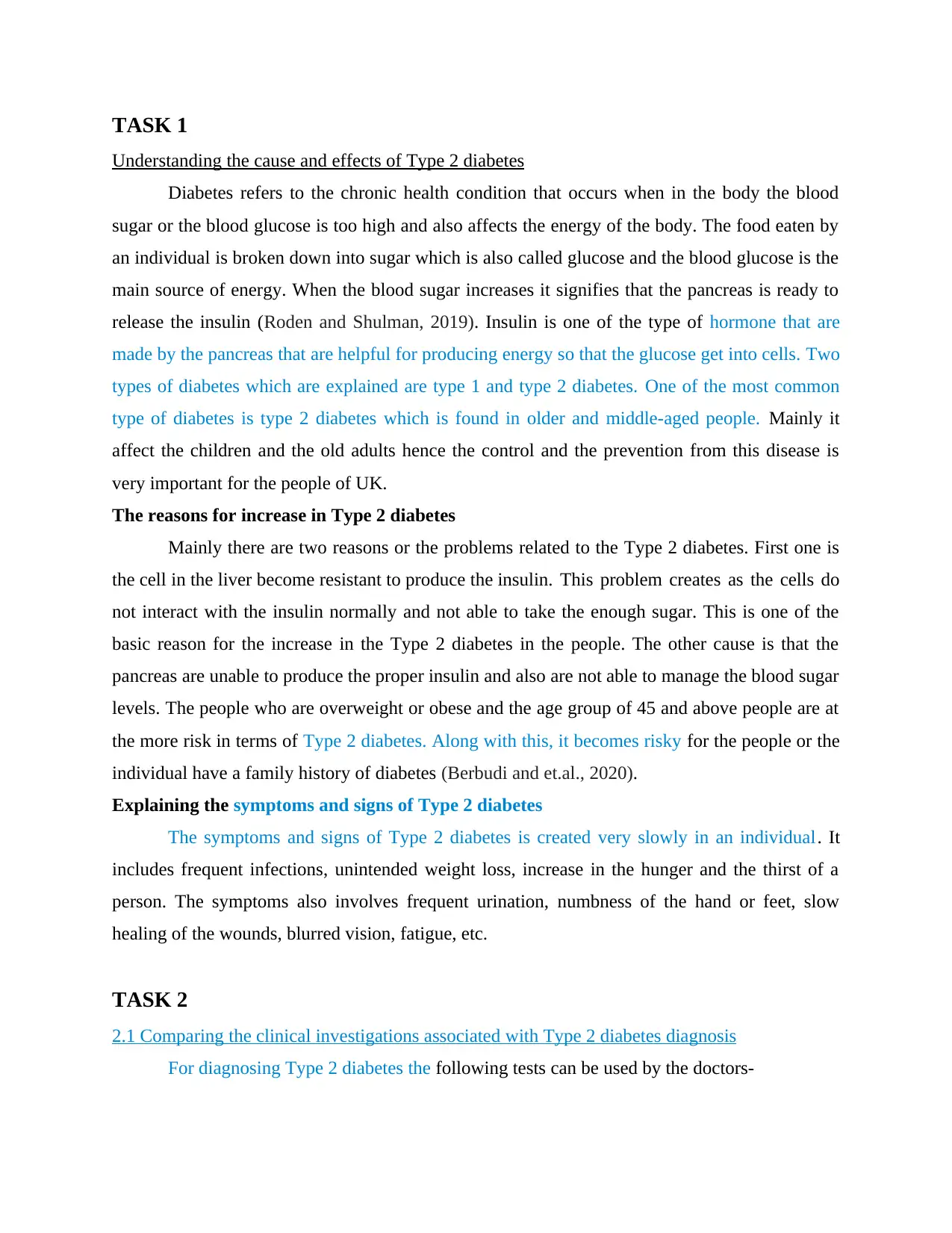
TASK 1
Understanding the cause and effects of Type 2 diabetes
Diabetes refers to the chronic health condition that occurs when in the body the blood
sugar or the blood glucose is too high and also affects the energy of the body. The food eaten by
an individual is broken down into sugar which is also called glucose and the blood glucose is the
main source of energy. When the blood sugar increases it signifies that the pancreas is ready to
release the insulin (Roden and Shulman, 2019). Insulin is one of the type of hormone that are
made by the pancreas that are helpful for producing energy so that the glucose get into cells. Two
types of diabetes which are explained are type 1 and type 2 diabetes. One of the most common
type of diabetes is type 2 diabetes which is found in older and middle-aged people. Mainly it
affect the children and the old adults hence the control and the prevention from this disease is
very important for the people of UK.
The reasons for increase in Type 2 diabetes
Mainly there are two reasons or the problems related to the Type 2 diabetes. First one is
the cell in the liver become resistant to produce the insulin. This problem creates as the cells do
not interact with the insulin normally and not able to take the enough sugar. This is one of the
basic reason for the increase in the Type 2 diabetes in the people. The other cause is that the
pancreas are unable to produce the proper insulin and also are not able to manage the blood sugar
levels. The people who are overweight or obese and the age group of 45 and above people are at
the more risk in terms of Type 2 diabetes. Along with this, it becomes risky for the people or the
individual have a family history of diabetes (Berbudi and et.al., 2020).
Explaining the symptoms and signs of Type 2 diabetes
The symptoms and signs of Type 2 diabetes is created very slowly in an individual. It
includes frequent infections, unintended weight loss, increase in the hunger and the thirst of a
person. The symptoms also involves frequent urination, numbness of the hand or feet, slow
healing of the wounds, blurred vision, fatigue, etc.
TASK 2
2.1 Comparing the clinical investigations associated with Type 2 diabetes diagnosis
For diagnosing Type 2 diabetes the following tests can be used by the doctors-
Understanding the cause and effects of Type 2 diabetes
Diabetes refers to the chronic health condition that occurs when in the body the blood
sugar or the blood glucose is too high and also affects the energy of the body. The food eaten by
an individual is broken down into sugar which is also called glucose and the blood glucose is the
main source of energy. When the blood sugar increases it signifies that the pancreas is ready to
release the insulin (Roden and Shulman, 2019). Insulin is one of the type of hormone that are
made by the pancreas that are helpful for producing energy so that the glucose get into cells. Two
types of diabetes which are explained are type 1 and type 2 diabetes. One of the most common
type of diabetes is type 2 diabetes which is found in older and middle-aged people. Mainly it
affect the children and the old adults hence the control and the prevention from this disease is
very important for the people of UK.
The reasons for increase in Type 2 diabetes
Mainly there are two reasons or the problems related to the Type 2 diabetes. First one is
the cell in the liver become resistant to produce the insulin. This problem creates as the cells do
not interact with the insulin normally and not able to take the enough sugar. This is one of the
basic reason for the increase in the Type 2 diabetes in the people. The other cause is that the
pancreas are unable to produce the proper insulin and also are not able to manage the blood sugar
levels. The people who are overweight or obese and the age group of 45 and above people are at
the more risk in terms of Type 2 diabetes. Along with this, it becomes risky for the people or the
individual have a family history of diabetes (Berbudi and et.al., 2020).
Explaining the symptoms and signs of Type 2 diabetes
The symptoms and signs of Type 2 diabetes is created very slowly in an individual. It
includes frequent infections, unintended weight loss, increase in the hunger and the thirst of a
person. The symptoms also involves frequent urination, numbness of the hand or feet, slow
healing of the wounds, blurred vision, fatigue, etc.
TASK 2
2.1 Comparing the clinical investigations associated with Type 2 diabetes diagnosis
For diagnosing Type 2 diabetes the following tests can be used by the doctors-
⊘ This is a preview!⊘
Do you want full access?
Subscribe today to unlock all pages.

Trusted by 1+ million students worldwide
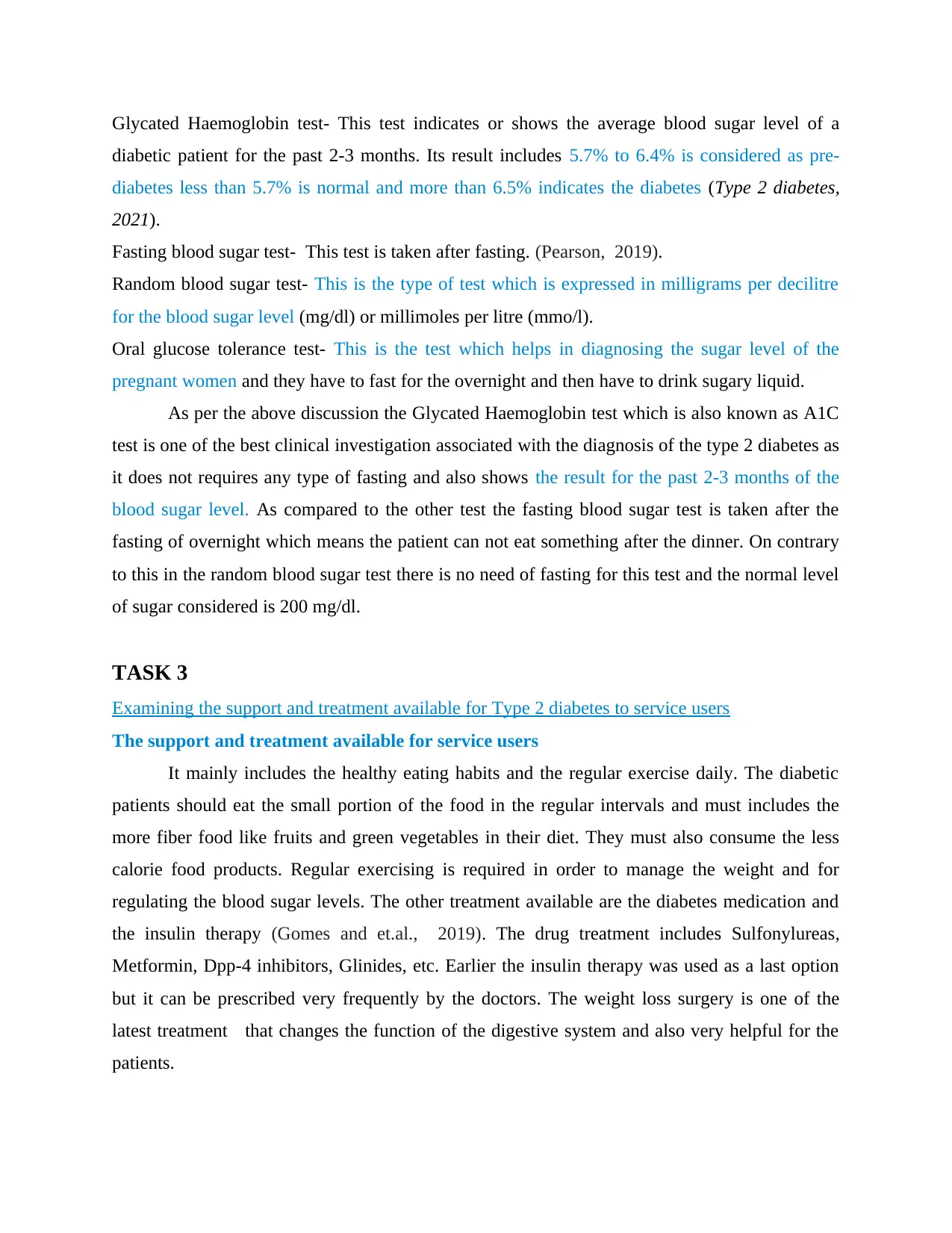
Glycated Haemoglobin test- This test indicates or shows the average blood sugar level of a
diabetic patient for the past 2-3 months. Its result includes 5.7% to 6.4% is considered as pre-
diabetes less than 5.7% is normal and more than 6.5% indicates the diabetes (Type 2 diabetes,
2021).
Fasting blood sugar test- This test is taken after fasting. (Pearson, 2019).
Random blood sugar test- This is the type of test which is expressed in milligrams per decilitre
for the blood sugar level (mg/dl) or millimoles per litre (mmo/l).
Oral glucose tolerance test- This is the test which helps in diagnosing the sugar level of the
pregnant women and they have to fast for the overnight and then have to drink sugary liquid.
As per the above discussion the Glycated Haemoglobin test which is also known as A1C
test is one of the best clinical investigation associated with the diagnosis of the type 2 diabetes as
it does not requires any type of fasting and also shows the result for the past 2-3 months of the
blood sugar level. As compared to the other test the fasting blood sugar test is taken after the
fasting of overnight which means the patient can not eat something after the dinner. On contrary
to this in the random blood sugar test there is no need of fasting for this test and the normal level
of sugar considered is 200 mg/dl.
TASK 3
Examining the support and treatment available for Type 2 diabetes to service users
The support and treatment available for service users
It mainly includes the healthy eating habits and the regular exercise daily. The diabetic
patients should eat the small portion of the food in the regular intervals and must includes the
more fiber food like fruits and green vegetables in their diet. They must also consume the less
calorie food products. Regular exercising is required in order to manage the weight and for
regulating the blood sugar levels. The other treatment available are the diabetes medication and
the insulin therapy (Gomes and et.al., 2019). The drug treatment includes Sulfonylureas,
Metformin, Dpp-4 inhibitors, Glinides, etc. Earlier the insulin therapy was used as a last option
but it can be prescribed very frequently by the doctors. The weight loss surgery is one of the
latest treatment that changes the function of the digestive system and also very helpful for the
patients.
diabetic patient for the past 2-3 months. Its result includes 5.7% to 6.4% is considered as pre-
diabetes less than 5.7% is normal and more than 6.5% indicates the diabetes (Type 2 diabetes,
2021).
Fasting blood sugar test- This test is taken after fasting. (Pearson, 2019).
Random blood sugar test- This is the type of test which is expressed in milligrams per decilitre
for the blood sugar level (mg/dl) or millimoles per litre (mmo/l).
Oral glucose tolerance test- This is the test which helps in diagnosing the sugar level of the
pregnant women and they have to fast for the overnight and then have to drink sugary liquid.
As per the above discussion the Glycated Haemoglobin test which is also known as A1C
test is one of the best clinical investigation associated with the diagnosis of the type 2 diabetes as
it does not requires any type of fasting and also shows the result for the past 2-3 months of the
blood sugar level. As compared to the other test the fasting blood sugar test is taken after the
fasting of overnight which means the patient can not eat something after the dinner. On contrary
to this in the random blood sugar test there is no need of fasting for this test and the normal level
of sugar considered is 200 mg/dl.
TASK 3
Examining the support and treatment available for Type 2 diabetes to service users
The support and treatment available for service users
It mainly includes the healthy eating habits and the regular exercise daily. The diabetic
patients should eat the small portion of the food in the regular intervals and must includes the
more fiber food like fruits and green vegetables in their diet. They must also consume the less
calorie food products. Regular exercising is required in order to manage the weight and for
regulating the blood sugar levels. The other treatment available are the diabetes medication and
the insulin therapy (Gomes and et.al., 2019). The drug treatment includes Sulfonylureas,
Metformin, Dpp-4 inhibitors, Glinides, etc. Earlier the insulin therapy was used as a last option
but it can be prescribed very frequently by the doctors. The weight loss surgery is one of the
latest treatment that changes the function of the digestive system and also very helpful for the
patients.
Paraphrase This Document
Need a fresh take? Get an instant paraphrase of this document with our AI Paraphraser
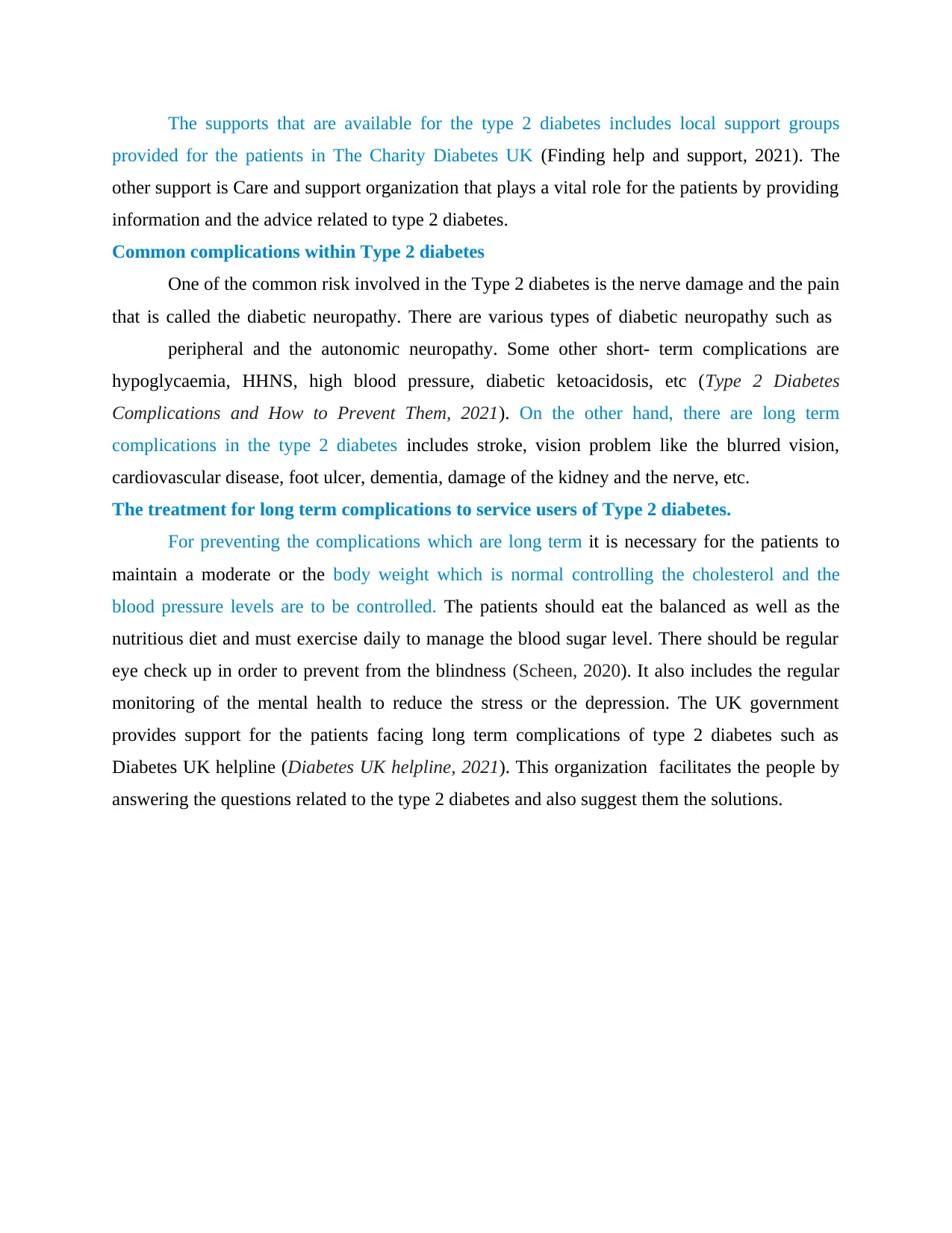
The supports that are available for the type 2 diabetes includes local support groups
provided for the patients in The Charity Diabetes UK (Finding help and support, 2021). The
other support is Care and support organization that plays a vital role for the patients by providing
information and the advice related to type 2 diabetes.
Common complications within Type 2 diabetes
One of the common risk involved in the Type 2 diabetes is the nerve damage and the pain
that is called the diabetic neuropathy. There are various types of diabetic neuropathy such as
peripheral and the autonomic neuropathy. Some other short- term complications are
hypoglycaemia, HHNS, high blood pressure, diabetic ketoacidosis, etc (Type 2 Diabetes
Complications and How to Prevent Them, 2021). On the other hand, there are long term
complications in the type 2 diabetes includes stroke, vision problem like the blurred vision,
cardiovascular disease, foot ulcer, dementia, damage of the kidney and the nerve, etc.
The treatment for long term complications to service users of Type 2 diabetes.
For preventing the complications which are long term it is necessary for the patients to
maintain a moderate or the body weight which is normal controlling the cholesterol and the
blood pressure levels are to be controlled. The patients should eat the balanced as well as the
nutritious diet and must exercise daily to manage the blood sugar level. There should be regular
eye check up in order to prevent from the blindness (Scheen, 2020). It also includes the regular
monitoring of the mental health to reduce the stress or the depression. The UK government
provides support for the patients facing long term complications of type 2 diabetes such as
Diabetes UK helpline (Diabetes UK helpline, 2021). This organization facilitates the people by
answering the questions related to the type 2 diabetes and also suggest them the solutions.
provided for the patients in The Charity Diabetes UK (Finding help and support, 2021). The
other support is Care and support organization that plays a vital role for the patients by providing
information and the advice related to type 2 diabetes.
Common complications within Type 2 diabetes
One of the common risk involved in the Type 2 diabetes is the nerve damage and the pain
that is called the diabetic neuropathy. There are various types of diabetic neuropathy such as
peripheral and the autonomic neuropathy. Some other short- term complications are
hypoglycaemia, HHNS, high blood pressure, diabetic ketoacidosis, etc (Type 2 Diabetes
Complications and How to Prevent Them, 2021). On the other hand, there are long term
complications in the type 2 diabetes includes stroke, vision problem like the blurred vision,
cardiovascular disease, foot ulcer, dementia, damage of the kidney and the nerve, etc.
The treatment for long term complications to service users of Type 2 diabetes.
For preventing the complications which are long term it is necessary for the patients to
maintain a moderate or the body weight which is normal controlling the cholesterol and the
blood pressure levels are to be controlled. The patients should eat the balanced as well as the
nutritious diet and must exercise daily to manage the blood sugar level. There should be regular
eye check up in order to prevent from the blindness (Scheen, 2020). It also includes the regular
monitoring of the mental health to reduce the stress or the depression. The UK government
provides support for the patients facing long term complications of type 2 diabetes such as
Diabetes UK helpline (Diabetes UK helpline, 2021). This organization facilitates the people by
answering the questions related to the type 2 diabetes and also suggest them the solutions.
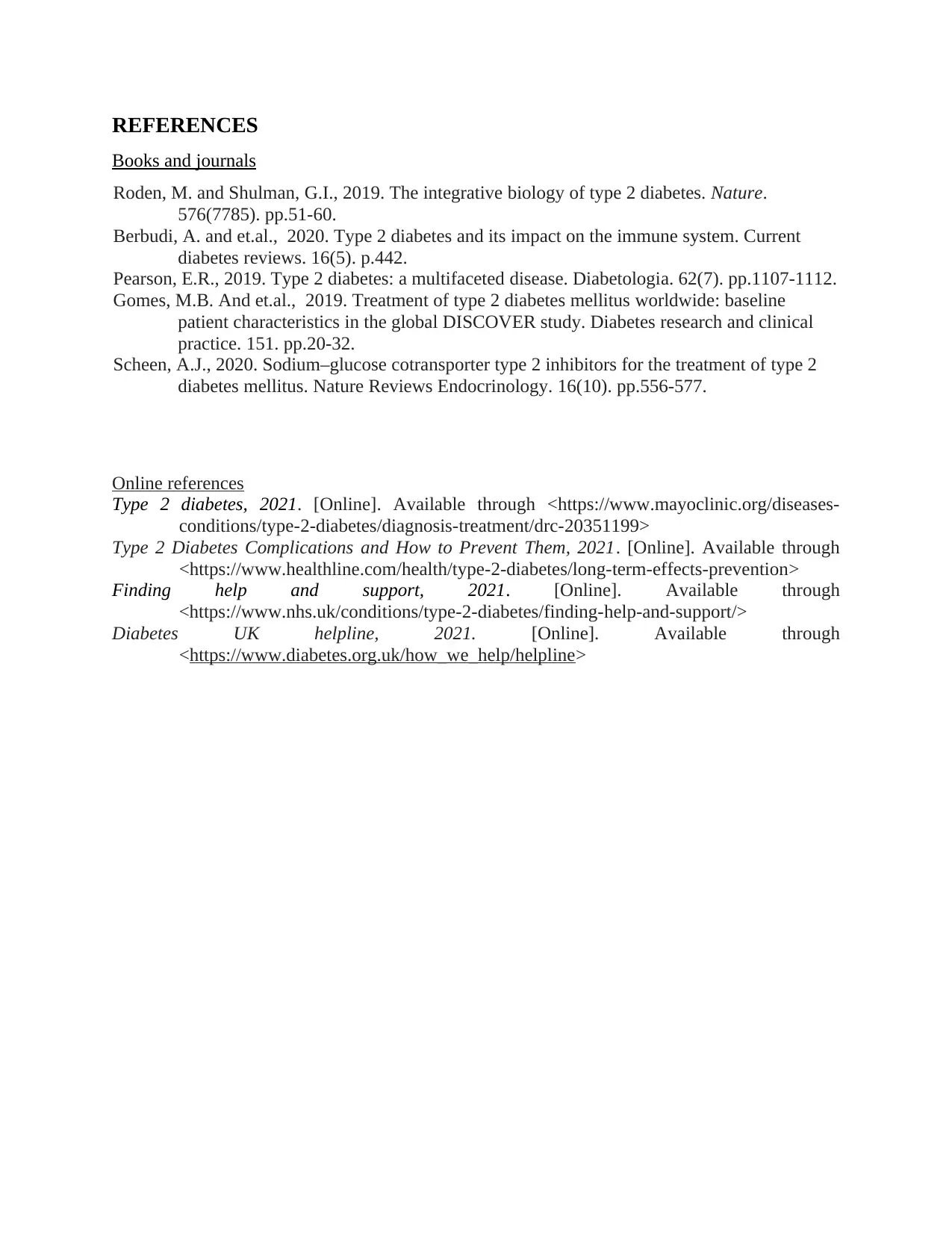
REFERENCES
Books and journals
Roden, M. and Shulman, G.I., 2019. The integrative biology of type 2 diabetes. Nature.
576(7785). pp.51-60.
Berbudi, A. and et.al., 2020. Type 2 diabetes and its impact on the immune system. Current
diabetes reviews. 16(5). p.442.
Pearson, E.R., 2019. Type 2 diabetes: a multifaceted disease. Diabetologia. 62(7). pp.1107-1112.
Gomes, M.B. And et.al., 2019. Treatment of type 2 diabetes mellitus worldwide: baseline
patient characteristics in the global DISCOVER study. Diabetes research and clinical
practice. 151. pp.20-32.
Scheen, A.J., 2020. Sodium–glucose cotransporter type 2 inhibitors for the treatment of type 2
diabetes mellitus. Nature Reviews Endocrinology. 16(10). pp.556-577.
Online references
Type 2 diabetes, 2021. [Online]. Available through <https://www.mayoclinic.org/diseases-
conditions/type-2-diabetes/diagnosis-treatment/drc-20351199>
Type 2 Diabetes Complications and How to Prevent Them, 2021. [Online]. Available through
<https://www.healthline.com/health/type-2-diabetes/long-term-effects-prevention>
Finding help and support, 2021. [Online]. Available through
<https://www.nhs.uk/conditions/type-2-diabetes/finding-help-and-support/>
Diabetes UK helpline, 2021. [Online]. Available through
<https://www.diabetes.org.uk/how_we_help/helpline>
Books and journals
Roden, M. and Shulman, G.I., 2019. The integrative biology of type 2 diabetes. Nature.
576(7785). pp.51-60.
Berbudi, A. and et.al., 2020. Type 2 diabetes and its impact on the immune system. Current
diabetes reviews. 16(5). p.442.
Pearson, E.R., 2019. Type 2 diabetes: a multifaceted disease. Diabetologia. 62(7). pp.1107-1112.
Gomes, M.B. And et.al., 2019. Treatment of type 2 diabetes mellitus worldwide: baseline
patient characteristics in the global DISCOVER study. Diabetes research and clinical
practice. 151. pp.20-32.
Scheen, A.J., 2020. Sodium–glucose cotransporter type 2 inhibitors for the treatment of type 2
diabetes mellitus. Nature Reviews Endocrinology. 16(10). pp.556-577.
Online references
Type 2 diabetes, 2021. [Online]. Available through <https://www.mayoclinic.org/diseases-
conditions/type-2-diabetes/diagnosis-treatment/drc-20351199>
Type 2 Diabetes Complications and How to Prevent Them, 2021. [Online]. Available through
<https://www.healthline.com/health/type-2-diabetes/long-term-effects-prevention>
Finding help and support, 2021. [Online]. Available through
<https://www.nhs.uk/conditions/type-2-diabetes/finding-help-and-support/>
Diabetes UK helpline, 2021. [Online]. Available through
<https://www.diabetes.org.uk/how_we_help/helpline>
⊘ This is a preview!⊘
Do you want full access?
Subscribe today to unlock all pages.

Trusted by 1+ million students worldwide
1 out of 6
Related Documents
Your All-in-One AI-Powered Toolkit for Academic Success.
+13062052269
info@desklib.com
Available 24*7 on WhatsApp / Email
![[object Object]](/_next/static/media/star-bottom.7253800d.svg)
Unlock your academic potential
Copyright © 2020–2025 A2Z Services. All Rights Reserved. Developed and managed by ZUCOL.





